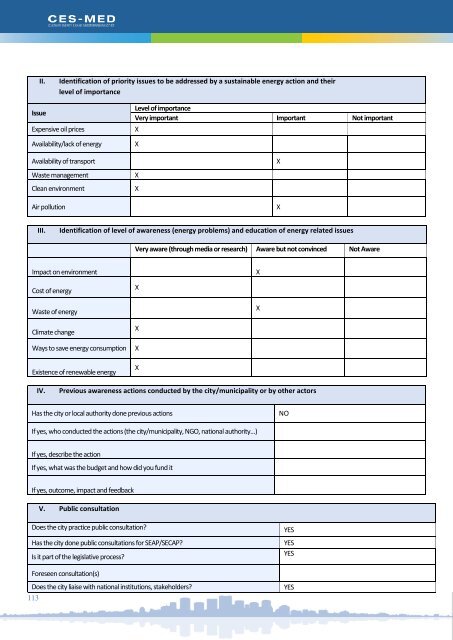171117_SECAP of Greater Irbid Municipality_SET_rev2
Create successful ePaper yourself
Turn your PDF publications into a flip-book with our unique Google optimized e-Paper software.
communities, the exposure has been assessed for the pilot area specifically and for the Kingdom to cover the adjacent<br />
urban centres; Amman and Salt.<br />
Adaptation measures suggested for the urban sector in the Third National Communication report on Climate Change (TNC)<br />
include:<br />
- Introduce climate responsive building techniques and elements to reduce the effect <strong>of</strong> heat and reduce demand on<br />
energy for cooling;<br />
- Promote the use <strong>of</strong> energy saving devices, and raise awareness on the long-term benefits <strong>of</strong> energy efficiency and<br />
saving devices;<br />
- Amendments to sector policies and regulations, such as building codes, to reflect climate change risks and direct<br />
people towards insulating buildings to reduce energy demand;<br />
- Construct proper storm water network to discharge storm water from built environment;<br />
- Zoning and development changes to reflect increased vulnerability <strong>of</strong> specific locations and/or resources.<br />
The following table explain the adaptation action related to Urban sector:<br />
Actions’<br />
characteristic<br />
Strategic<br />
Alert /<br />
Communication<br />
Educational<br />
Technical<br />
Adaptation Actions<br />
Modification <strong>of</strong> building codes to allow more energy efficient and heat<br />
tolerant structures<br />
Modification <strong>of</strong> building codes against seismic activity<br />
Provision <strong>of</strong> reductions on the municipal taxes for those proceeding in<br />
adoption <strong>of</strong> adaptation measures in their houses<br />
Integrated land use planning with zoning system depending on the<br />
different areas (e.g. red for areas to be heavily afflicted by floods or sea<br />
level rise)<br />
Not applicable<br />
Educational campaigns on informing the citizens on the benefits <strong>of</strong><br />
adopting the suggested actions in their premises<br />
Greening infrastructure such as buildings’ ro<strong>of</strong>s and walls<br />
Increasing the amount <strong>of</strong> shade and green areas in the city by planting<br />
trees to reduce the heat island effect<br />
Building exemplary districts with adapted urban forms and buildings<br />
White ro<strong>of</strong>s (cool colours), shading and bioclimatic design<br />
Rainwater collection and use Adoption <strong>of</strong> methods to reduce water demand<br />
Using water resistant construction materials<br />
Estimated cost in<br />
JOD<br />
100,000<br />
Years <strong>of</strong> Implementation<br />
Adaptation actions for economy<br />
Agriculture Sector:<br />
Poor in rural areas in Jordan are expected to face the most severe consequences <strong>of</strong> climate change through disruption <strong>of</strong><br />
livelihood options that depend on natural resource management. The expected impacts <strong>of</strong> climate change particularly<br />
reduced agricultural productivity and water availability threatens livelihoods and keeps vulnerable people insecure. Poor<br />
families and households are the most vulnerable group to the impacts <strong>of</strong> climate change and deserve the priority the in<br />
design <strong>of</strong> appropriate adaptive measures.<br />
The major climate exposure risks associated with agriculture in Jordan were identified as:<br />
1. Temperature increase;<br />
2. Rainfall decrease;<br />
3. Droughts and<br />
106

















